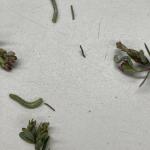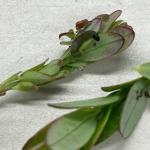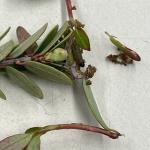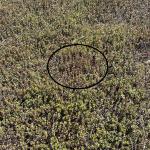The Diagnostic Lab is up and running, and available during our normal operating hours! The Diagnostic Lab is room 121 in the lab building. Once you arrive at the Cranberry Station please enter through our main entrance and follow signs directing you upstairs toward the Diagnostic Lab. Feel free to bring in your sweep nets and use the microscopes yourself to help identify your pests. One of the microscopes has a video screen attached, so you can take a clear picture of the pest.
If you have a sample you want us to look at or diagnose and there is no one around to help; this is the area designated for diagnostic sample drop-offs. You will see an area with bags, markers, and intake forms. You can drop-off vine, soil, fruit, weeds, and insects.
To leave a sample
- Fill out the intake form.
- Label the sample bag with name, bog details and date that sample was collected.
- Place your sample in the small refrigerator labeled “Diagnostic Samples”.
- Place your intake form in the wall mounted file holder.
When collecting your sample, be sure to include all necessary material needed for diagnosis. If you are bringing weeds, please bring a healthy weed with as much of the plant intact as possible (stems, flowers, leaves, etc.). If you are bringing in cranberry vines from a problem area, please bring a sample from the affected area as well as some vines from the edge of that affected area. If you suspect phytophthora or other root problems, ensure that your vine sample includes roots. If you bring samples in your own bag, please place that bag into our provided bags and seal it before placing it into the refrigerator to avoid contamination between samples.
Some samples may take a week to be processed, but someone will call you within 48 hours of receiving the sample to acknowledge that it was received and to give a timeframe of when you should expect results.
Insect Management.
Weevil counts for most have been up just as expected. This weekend is a good time to apply Fanfare, Avaunt or Actara to manage them before flower pods appear for egglaying. Green spanworm has continued to be found on a few bogs in high enough numbers to warrant treatment. There is a huge range in size with incredibly small thread size spanworm, medium, and full size 1” spanworm found. We have even had them start to pupate in the lab this week! If you need to treat for high counts of green spanworm, NOW is the time!
Black-headed fireworm (BHF) has been seen in sweeps on a few sites. They are not tiny; they are already nearly full-size (which for BHF is still very small) and are webbed up in the tip of the uprights. If you have a history of BHF, NOW is the time to manage. They develop quickly and will pupate soon.
Scale spots have just started to appear. Off-color round areas may be percolating scale spots. Inspect the uprights for small round black spots towards the base of the upright. Samples of uprights can be dropped off at the station or you can use the microscopes in the diagnostic lab yourself to look! If you confirm that you have a live scale infestation, you must wait until mid-June to manage this insect. They are protected under their covering until they start releasing their crawler phase.
Weed Management.
With the warmer weather, lots of weeds are making their appearance. Different grass species are actively growing and can be treated with grass herbicides (sethoxydim/Poast and clethodim/SelectMax, Intensity One, etc.) – but NOT poverty grass yet! PG is just hanging around, waiting for warmer weather, and not still not actively growing.
Remember, you can use the grass herbicides more than once per season. If you have multiple grass species with different active growth windows, you can treat them at different times.
We do NOT recommend using clethodim products during roughneck. When used during this cranberry growth stage it can cause some floral deformities that usually show up as fused petals (flowers never fully open). Howes are especially sensitive to this. Although the flowers look abnormal, we were never able to document a decrease in yield due associated with fused flowers.
Although poison ivy is leafing out now, flowering, and becoming more visible. Our research showed that it is better to wait until later (mid-June) to spot treat with concentrated Callisto rather than to treat it now. Let the plant invest more of its saved resources on bigger leaves and making seeds before knocking it back.
A grower asked whether Kerb should be watered in or not. In general, the preemergence herbicides are active in the soil. That means you want them in the soil and not on the plants. Most soil active herbicide labels will have some info about incorporating the material into the soil. For Kerb, an application should be followed by irrigation or rainfall within 3 days of application. It is less stable when air temps are higher, so you may want to rinse it in after injecting during this time of year – especially if you don’t plan on irrigating/frost/rain in the next few days. But also be aware that excessive water can wash it too deeply into the soil to be effective. You want it to remain in the top few inches of the soil (root zone).





